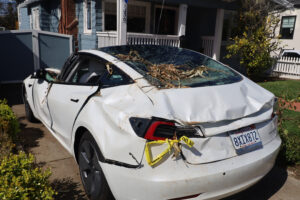
Reuters probe highlights claims delays, other issues with Tesla’s branded insurance
By onBusiness Practices | Collision Repair | Insurance | Market Trends
A Reuters investigation has uncovered concerns with Tesla’s branded insurance, alleging some drivers have waited several months for claims payouts.
In a wire service feature published last week, some Tesla drivers alleged that they encountered issues with the OEM’s insurance related to indemnification and poor customer service.
One such story involved policyholder Mark Bova, who said an Autopilot malfunction caused his Model S to smash into a median and flip earlier this year, leaving him with $50,000 in medical bills.
“I’m a former Green Beret,” Bova told Reuters. “That was probably the second-most traumatic thing I’ve gone through other than being in combat.”
Despite several months passing since the February collision, he said he has yet to be compensated for his medical expenses. It took seven months to receive payout on his total loss claim, he added.
Separately, California policyholder Scott Sawyer told Reuters that it took seven months to have his 2021 Model Y repaired after it was rear-ended by a pickup truck in February 2022. It’s worth noting that numerous people experienced delays in having their vehicles repaired around that time, and delays continue to persist, due to parts and labor shortages.
However, Sawyer said he filed another claim last August after his car, which was parked outside his home, was struck by a minivan in a separate incident.
He said a month passed without receiving a response from Tesla.
“We have tried emailing, calling, texting and the claims adjuster will not respond,” his wife, Lauren Lee Sawyer, wrote on Facebook. “I am furious. I hate that I am making payments on a totaled car.”
Her husband said he ultimately complained to the Better Business Bureau and California Department of Insurance, and that he eventually heard from a claims adjuster who estimated the vehicle sustained $10,000 in damage, Reuters said.
A trip to the body shop, at Sawyer’s insistence, determined it was more economical to write the vehicle off and he was offered nearly $45,000 to settle the claim.
Neither Tesla nor its CEO Elon Musk responded to Reuters’ questions, the outlet said.
Other drivers also detailed to Reuters how they waited months for claims payouts, or struggled to reach a Tesla representative for help on things like obtaining proof of insurance.
The issue of drivers getting dinged on safety scores when their vehicles were being tested by technicians following maintenance or a collision was also addressed.
Repairer Driven News previously shared an example provided by a reader that demonstrated how performing a necessary set of driving conditions on a customer’s Tesla negatively affected their auto insurance Safety Score.
When asked how to handle the situation, Tesla said the vehicle should’ve been put into service mode during the test drive. Service Mode, according to Tesla’s website, is a “diagnostic and repair interface available on the vehicle touchscreen to help both internal and 3rd party technicians service Tesla vehicles more efficiently.”
Service Mode limits remote access to the vehicle, implements a speed limiter, and allows for the repair facility to conduct necessary steps in troubleshooting and repairing the vehicle.
The issues highlighted by Reuters are just a sampling of concerns drivers have had with Tesla’s insurance. At least that’s what a scan of Better Business Bureau (BBB) reviews indicates. The site is rife with consumer complaints related to delays and customer service.
Tesla Insurance was launched in California in September 2020. It offers coverage for current and new Tesla vehicle owners, and Tesla owners can add vehicles made by other manufacturers to their policies. It has since expanded to nearly a dozen additional states.
Meanwhile, a new Swiss Re report released last week showed that the insurance industry is strengthening its resiliency amid a challenging environment.
“Fading economic tailwinds and geopolitical uncertainties reinforce the primary insurance industry’s essential role in risk transfer,” Jérôme Jean Haegeli, Swiss Re’s Group Chief Economist, said in a press release. “While the sector will continue to strengthen its profitability, mainly driven by improved risk-adjusted pricing as well as higher investment returns, it is not yet expected to earn its cost of capital in 2024 or 2025 in most markets as economic inflation will continue to have a negative impact on claims costs.”
According to the report, total premium growth is forecasted to be 2.2% annually on average for the next two years, higher than the 1.6% average observed from 2018 through 2022. The situation is looking even more promising in the P&C sector, it said, adding that premium growth will likely reach 3.4% globally this year and 2.6% in 2024 and 2025.
“The improvements in profitability are driven by higher investment returns given the higher interest rate environment, as well as better underwriting results due to more commensurate premium rates in both commercial and personal lines,” the report said. “Underwriting is also being supported by disinflation and improved terms and conditions, which are expected to increasingly mitigate the effects of inflation on claims costs.”
It said labor market strength was another driver of industry resilience, noting that unemployment rates within the U.S. reached a record low of 3.9% in October.
Images
Featured image courtesy of Arun1/iStock
